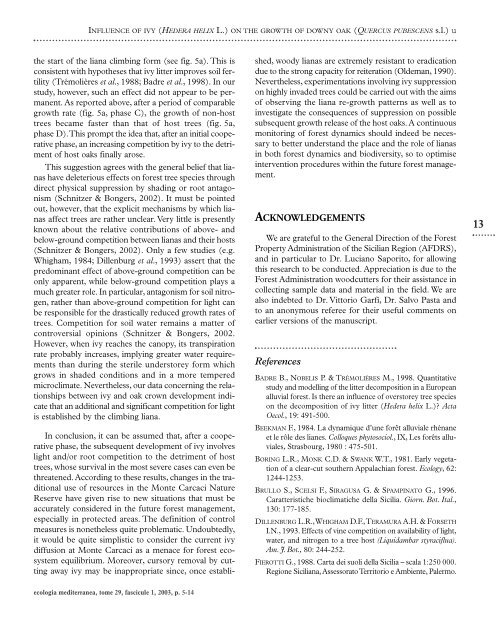introduction - Ecologia Mediterranea
introduction - Ecologia Mediterranea
introduction - Ecologia Mediterranea
Create successful ePaper yourself
Turn your PDF publications into a flip-book with our unique Google optimized e-Paper software.
INFLUENCE OF IVY (HEDERA HELIX L.) ON THE GROWTH OF DOWNY OAK (QUERCUS PUBESCENS s.l.) u<br />
the start of the liana climbing form (see fig. 5a). This is<br />
consistent with hypotheses that ivy litter improves soil fertility<br />
(Trémolières et al., 1988; Badre et al., 1998). In our<br />
study, however, such an effect did not appear to be permanent.<br />
As reported above, after a period of comparable<br />
growth rate (fig. 5a, phase C), the growth of non-host<br />
trees became faster than that of host trees (fig. 5a,<br />
phase D).This prompt the idea that, after an initial cooperative<br />
phase, an increasing competition by ivy to the detriment<br />
of host oaks finally arose.<br />
This suggestion agrees with the general belief that lianas<br />
have deleterious effects on forest tree species through<br />
direct physical suppression by shading or root antagonism<br />
(Schnitzer & Bongers, 2002). It must be pointed<br />
out, however, that the explicit mechanisms by which lianas<br />
affect trees are rather unclear. Very little is presently<br />
known about the relative contributions of above- and<br />
below-ground competition between lianas and their hosts<br />
(Schnitzer & Bongers, 2002). Only a few studies (e.g.<br />
Whigham, 1984; Dillenburg et al., 1993) assert that the<br />
predominant effect of above-ground competition can be<br />
only apparent, while below-ground competition plays a<br />
much greater role. In particular, antagonism for soil nitrogen,<br />
rather than above-ground competition for light can<br />
be responsible for the drastically reduced growth rates of<br />
trees. Competition for soil water remains a matter of<br />
controversial opinions (Schnitzer & Bongers, 2002.<br />
However, when ivy reaches the canopy, its transpiration<br />
rate probably increases, implying greater water requirements<br />
than during the sterile understorey form which<br />
grows in shaded conditions and in a more tempered<br />
microclimate. Nevertheless, our data concerning the relationships<br />
between ivy and oak crown development indicate<br />
that an additional and significant competition for light<br />
is established by the climbing liana.<br />
In conclusion, it can be assumed that, after a cooperative<br />
phase, the subsequent development of ivy involves<br />
light and/or root competition to the detriment of host<br />
trees, whose survival in the most severe cases can even be<br />
threatened. According to these results, changes in the traditional<br />
use of resources in the Monte Carcaci Nature<br />
Reserve have given rise to new situations that must be<br />
accurately considered in the future forest management,<br />
especially in protected areas. The definition of control<br />
measures is nonetheless quite problematic. Undoubtedly,<br />
it would be quite simplistic to consider the current ivy<br />
diffusion at Monte Carcaci as a menace for forest ecosystem<br />
equilibrium. Moreover, cursory removal by cutting<br />
away ivy may be inappropriate since, once establi-<br />
ecologia mediterranea, tome 29, fascicule 1, 2003, p. 5-14<br />
shed, woody lianas are extremely resistant to eradication<br />
due to the strong capacity for reiteration (Oldeman, 1990).<br />
Nevertheless, experimentations involving ivy suppression<br />
on highly invaded trees could be carried out with the aims<br />
of observing the liana re-growth patterns as well as to<br />
investigate the consequences of suppression on possible<br />
subsequent growth release of the host oaks. A continuous<br />
monitoring of forest dynamics should indeed be necessary<br />
to better understand the place and the role of lianas<br />
in both forest dynamics and biodiversity, so to optimise<br />
intervention procedures within the future forest management.<br />
ACKNOWLEDGEMENTS<br />
We are grateful to the General Direction of the Forest<br />
Property Administration of the Sicilian Region (AFDRS),<br />
and in particular to Dr. Luciano Saporito, for allowing<br />
this research to be conducted. Appreciation is due to the<br />
Forest Administration woodcutters for their assistance in<br />
collecting sample data and material in the field. We are<br />
also indebted to Dr. Vittorio Garfì, Dr. Salvo Pasta and<br />
to an anonymous referee for their useful comments on<br />
earlier versions of the manuscript.<br />
References<br />
BADRE B., NOBELIS P. & TRÉMOLIÈRES M., 1998. Quantitative<br />
study and modelling of the litter decomposition in a European<br />
alluvial forest. Is there an influence of overstorey tree species<br />
on the decomposition of ivy litter (Hedera helix L.)? Acta<br />
Oecol., 19: 491-500.<br />
BEEKMAN F., 1984. La dynamique d’une forêt alluviale rhénane<br />
et le rôle des lianes. Colloques phytosociol., IX, Les forêts alluviales,<br />
Strasbourg, 1980 : 475-501.<br />
BORING L.R., MONK C.D. & SWANK W.T., 1981. Early vegetation<br />
of a clear-cut southern Appalachian forest. Ecology, 62:<br />
1244-1253.<br />
BRULLO S., SCELSI F., SIRAGUSA G. & SPAMPINATO G., 1996.<br />
Caratteristiche bioclimatiche della Sicilia. Giorn. Bot. Ital.,<br />
130: 177-185.<br />
DILLENBURG L.R.,WHIGHAM D.F.,TERAMURA A.H. & FORSETH<br />
I.N., 1993. Effects of vine competition on availability of light,<br />
water, and nitrogen to a tree host (Liquidambar styraciflua).<br />
Am. J. Bot., 80: 244-252.<br />
FIEROTTI G., 1988. Carta dei suoli della Sicilia – scala 1:250 000.<br />
Regione Siciliana, Assessorato Territorio e Ambiente, Palermo.<br />
13
















